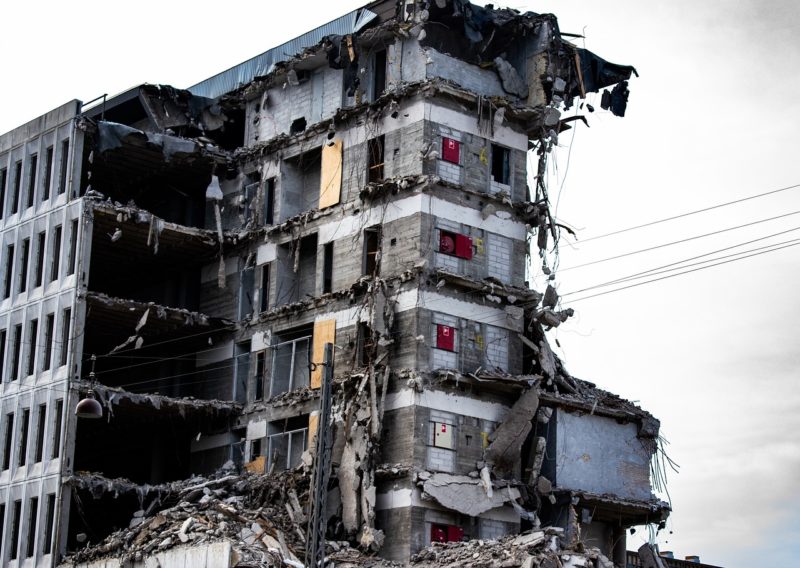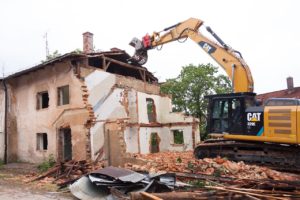demolition and refurbishment
Ensuring structural stability during demolition and refurbishment work
Following the airing of the first episode of the Channel 5 documentary ‘When Demolitions Go Wrong‘ HSE offers a reminder to demolition and construction firms of the need to review their processes. The article focusses on thorough planning, management and control of demolition and refurbishment work.

Sarah Jardine, HSE’s Head of Construction Operations in the Midlands and North West, says: “Structural instability can be a problem in buildings that are old, decayed, poorly maintained, and in newer buildings that have been badly designed and constructed or abused in use. Even sound structures can become unstable because of a lack of planning of construction and demolition work.
“Demolishing large, complex structures is a particularly high-hazard activity. Doing it safely is highly complex and technical, and relevant expertise is vital. These jobs require careful planning and execution by contractors who are competent in the full range of demolition techniques, and who have access to designers and engineers with the right knowledge, skills, and experience in this area.”
Mrs Jardine explains that businesses that properly plan, organise, manage and monitor their work and use competent people are not only avoiding accidents and ill health to their workers, but are also more efficient. She is adamant that up-front planning pays dividends with contracts generally coming in on time and budget with fewer added costs, and often to a higher quality.
She added: “Accidents caused by poor planning and risks management can have substantial human costs that are felt for many years by the victims and their families.
“In addition to the impact on people’s lives, accidents can also lead to substantial remediation costs, higher insurance premiums, and, if HSE investigates, court fines and prison sentences, with the inevitable impact on an individual’s and a firm’s reputations. As well as being morally right, it is simply common sense and good business to ensure rigorous planning, organising, managing and monitoring of the whole project.”
Demolition
 HSE publishes guidance for businesses involved in construction and demolition.
HSE publishes guidance for businesses involved in construction and demolition.
In particular, HSE sets out what those involved in demolition need to know, and recognises that a systematic approach to demolition projects is a team effort between many people, who all have responsibilities:
- Clients must appoint duty holders who have the relevant skills, knowledge, experience and the organisational capability, and who are adequately resourced.
- Clients, with the help of the principal designer must provide those who need it (e.g. designers, contractors) with pre-construction information that can reasonably be obtained. A range of surveys and reports will be needed – for example, to check for presence of asbestos; structural stability of site and nearby structures; the location of above and below ground live services in the work area; etc. These should be done before work begins and not be left for the principal contractor to organise once the demolition work has started.
- Principal designers must plan, manage, monitor and coordinate health and safety issues in the pre-construction phase (i.e. before demolition starts) to give principal contractors as much information as possible to allow the principal contractor to keep people (site workers and the public) safe.
- Principal contractors must plan, manage, monitor and coordinate health and safety issues during the demolition work.
- Site managers must ensure workers are supervised and are following safe working practice.
- Sub-contractors and site workers must follow the instructions and plans given to them by those in charge of the work and ensure that their colleagues do too.
Crucial to avoiding an uncontrolled collapse of a building is a structural survey that should consider:
- The age of the structure;
- Design codes used and designed use;
- The type of construction;
- Its history in use, including alterations;
- Nearby buildings or structures;
- The effect of additional weight of demolition machinery and debris on suspended floors.
Method statement
The method statement for the demolition should identify the sequence required to prevent accidental collapse of the structure.
There are lots of ways this can be achieved, including;
- Clients need to understand the work to be undertaken, and to provide suitable pre-construction/demolition information to designers and contractors. This includes building plans (including as-built drawings), structural assessment, along with environmental, contaminant and ground surveys. Design and planning based on hard facts allows confident costing and reduced contingency funding.
- Contractor competence. Do they have experience of the type of work they are bidding to undertake? And can they demonstrate a tight system for planning and organising work? Are they being honest about their actual role in previous similar work? Do they have the ability to understand what is required of them to carry out the project safely and successfully?
- Structural investigation. If there are no clear plans and records as to how the structure was designed and built, and/or subsequently adapted, it is important that a project structural engineer is appointed and that they check the available information is accurate. Failure to do this is a common factor in incidents. If existing information is inadequate then investigation will be needed to determine the structure of the building and assess whether it will remain stable at each stage of the work. This can affect the proposed sequencing of work and the need for temporary works – all of which needs preparation time.
- The designer must seek to make their design straightforward to follow. This includes informing the contractor of the sequence and method of work that they have assumed will be used; pointing out where temporary works will be needed to stabilise the incomplete structure; and advising of any unusual hazards that the designer has not managed to design out. Assuming knowledge of the structure based purely on previous experience of ‘similar’ structures should be avoided.
- Temporary works often need a specialist engineer to find the most suitable and cost-effective solution. Early identification and coordination of problems involving temporary conditions that need temporary works solutions allows early design and use of suitable contractors, methods of work and equipment. Leaving this to the last minute at best encourages expensive solutions that may not be as effective as hoped, and at worst allows short cuts and unsuitable methods that dramatically increase the likelihood that an incident will occur.
- Independent checks. It is important that the concept, assumptions and temporary works control measures selected by the designer/contractor are assessed by someone who has not previously been involved in that part of the design. In general, the less experience a designer has with the type of work involved, the greater the need for a fully independent check by a separate organisation. In some situations, a fully independent check is always needed. This will be the case where unusual or novel methods are proposed; where there is uncertainty or disagreement about the condition of the structure or the ability of temporary works to provide support it if local failure occurs; where the result of any failure would be progressive and widespread collapse; and where the foreseeable (likely) outcome of an incident would be heavy casualties or would involve members of the public.
- Clear and effective communication must exist between all the parties and suitable management checks must be in place to ensure that plans of work are both fully developed and being followed. Each party must understand exactly what their role and responsibilities are. Failure to understand and follow agreed systems of work is a common factor in structural incidents.
- By actively monitoring activity and the effectiveness of communications those managing the project can see what is working and what isn’t effective enough. This allows weakness to be identified and corrected before things can deteriorate to the point where an incident is likely.
Ensuring structural stability during demolition and refurbishment work
HSE offers a reminder to demolition and construction firms of the need to review their processes when it comes to demolition and refurbishment work.
Safety & Health Practitioner
SHP - Health and Safety News, Legislation, PPE, CPD and Resources Related Topics
Housing company fined more than £500k after worker suffers burns
Company fined as worker has leg amputated
Aviation company fined after worker death at Heathrow Airport


 HSE publishes
HSE publishes